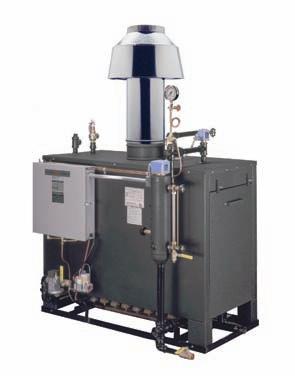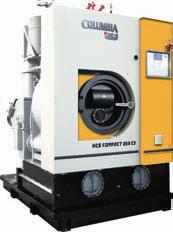














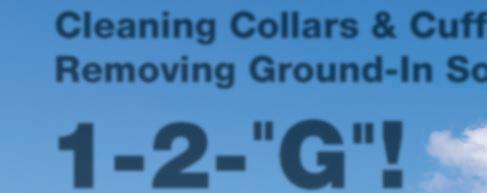






"G"Go quickly penetrates fabric to release ground-in soil, collar and cuff stains, perspiration, etc. Simply spray soiled areas before drycleaning. No brushing, flushing or waiting required. Stains and soil disappear right in the wheel. "G"Go works as a leveling agent, too!
And "G"Go is environmentally friendly. It’s soy-based, biodegradable, non-combustible and California VOC and Prop-65 compliant. Just spray it on and dryclean it out. With "G"Go, it’s as easy as 1-2-"G"!





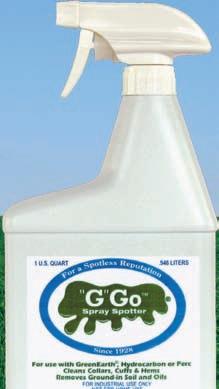
To learn more, visit
Bruce

Rainbow Cleaners earned Best Plant Design for its new plant that invites customers to watch all of the activity inside. Get the details on it and the year’s other notable projects.
Bruce Beggs







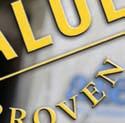
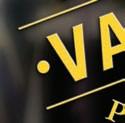

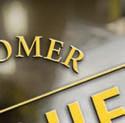

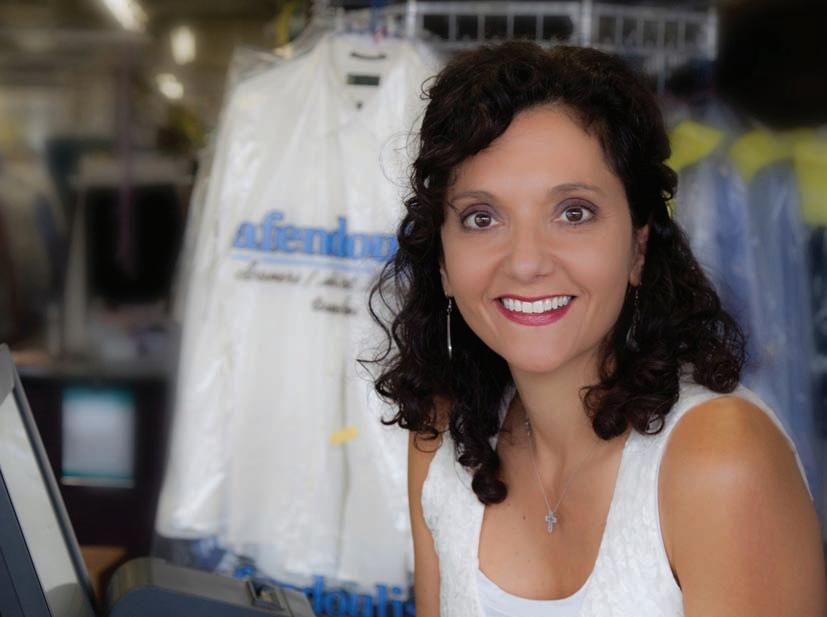
Becky Afendoulis, Owner of Afendoulis Cleaners
Bruce Beggs
For more than a half-century, American Drycleaner has recognized the top new plants each year through its Annual Plant Design Awards. The grand prize-winner this year is Rainbow Cleaners, Oxford, Miss., which invested more than $1 million to build a bright, airy plant store that invites customers to see all the work that goes into cleaning their garments. Having watching his staff work dutifully in what once had been a steak house, owner Herron Rowland wanted to open up a new space and let
Publisher
Charles Thompson 312-361-1680 cthompson@american trademagazines.com
Editorial Director Bruce Beggs 312-361-1683 bbeggs@american trademagazines.com

Production Manager
Roger Napiwocki
National Sales Director

Donald Feinstein 312-361-1682 dfeinstein@american trademagazines.com
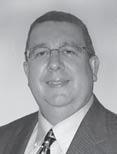
Digital Media Director
Nathan Frerichs 312-361-1681 nfrerichs@american trademagazines.com Main: 312-361-1700 Fax: 312-361-1685
the light shine in. Plus, a New Orleans hotel gave him the idea to light things up outside, too. Learn more about his vision beginning on page 32.
Other standouts this year include a dry cleaner that expanded from route service into a retail storefront, a plant store with a call area that evokes elegance, and a new build designed to serve a growing population.
Are you ready to invest in renovations, equipment upgrades, or a whole new plant? If so, document your progress and enter your plant in the next Plant Design Awards.
E-mail me at bbeggs@american trademagazines.com today to learn how you can enter. O
Contributing Editors
SUBSCRIPTIONS 630-739-0600 www.american drycleaner.com
American Drycleaner (ISSN 0002-8258) is published monthly except Nov/Dec combined. Subscription prices, payment in advance: U.S. and Possessions, 1 year $39.00; 2 years $73.00. Foreign, 1 year $89.00; 2 years $166.00. Single copies $7.00 for U.S. and Possessions, $14.00 for all other countries. Published by American Trade Magazines LLC, 566 West Lake Street, Suite 420, Chicago, IL 60661. Periodicals postage paid at Chi cago, IL and at additional mailing offices.
POSTMASTER, Send changes of address and form 3579 to American Drycleaner, Subscription Dept., 440 Quadrangle Drive, Suite E, Bolingbrook, IL 60440 Volume 79, number 9. Editorial, executive and advertising of fices are at 566 West Lake Street, Suite 420, Chicago, IL 60661. Charles Thompson, President and Publisher. American Drycleaner is distributed selectively to: qualified dry cleaning plants and distributors in the United States. No material appearing in American Drycleaner may be reprinted without written permission. The pub lisher reserves the right to reject any advertising for any reason. © Copyright AMERICAN TRADE MAGAZINES LLC, 2013. Printed in U.S.A.
American Drycleaner, January 2013 www.americandrycleaner.com


CHICAGO — Half of dry cleaners asked to offer their rough forecasts for sales in 2013 believe that volume will improve in their area next year, according to the results of American Drycleaner’s final Wire survey for 2012.
Sales volume will either “improve substantially, with at least a 5% yearto-year gain” (18.8%) or “bounce back a little, with a gain of 0% to 5%” (31.3%), these respondents predict.
But there are times when an increase in business for one cleaner means that other cleaners may be suffering or have even closed. “The market in our area is improving. Weaker competition is failing,” wrote one respondent.
Approximately 38% of respondents predict that volume will stay “essentially flat” in 2013, while the remaining 12.5% foresee a “slow-but-steady” year-to-year decline of 0% to 5%.
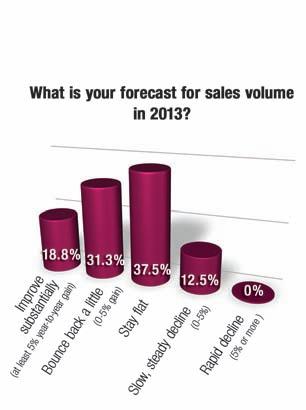
“There is still a considerable amount of uncertainty among businesses and consumers,” opined one respondent. “We are still seeing irrational responses to any market news.”
When asked about initiatives they have planned to help increase sales in 2013, many respondents said their efforts will involve continuing or improving upon their marketing programs to increase visibility. One is planning a
“full-on” campaign to promote a new cleaning system.

Other cleaners are looking at keeping prices low. “We are at break-even, but as long as we keep our employees working, then we, as owners, will take the hit,” wrote a respondent.
One operator is looking toward expansion. “While we do not expect significant growth in same-store numbers, we also feel the market desperately looking for good news. We are looking for locations for new stores.”
The Wire survey presents a snapshot of readers’ viewpoints but should not be considered scientific. Subscribers to Wire e-mails are invited to take the industry survey anonymously online each month.
WASHINGTON — A month after Hur ricane Sandy devastated the East Coast, the U.S. Small Business Administration has approved more than $150 million in low-interest disaster loans to about 2,500 homeowners, renters and businesses in New York, New Jersey, Connecticut and Rhode Island.
If your dry cleaning business was dam aged by the storm, there are several ways to apply for SBA disaster relief assistance:
• Apply online at https://disasterloan. sba.gov/ela
• For information about the disaster loan process, or to have an applica tion mailed to you, e-mail disaster customerservice@sba.gov or call 800659-2955 (800-877-8339 for the deaf and hard-of-hearing)
• Call the Federal Emergency Manage ment Agency (FEMA) to register for federal assistance at 800-621-3362
• T o be considered for all forms of disaster assistance, register online at www.disasterassistance.gov , or use your mobile device at http://m.fema. gov
• Visit an SBA Small Business Devel opment Center for help in completing loan applications and to gain advice on how to rebuild and grow in the af termath of the disaster. Locate one by visiting www.sba.gov/local-assistance The filing deadline for physical prop erty damage was Dec. 31 for businesses in New York, New Jersey and Connecticut, and is Jan. 15 for those in Rhode Island.
Top stories @ AmericanDrycleaner.com for the 30 days ending Dec. 10
Top News sTories
1. StatShot: Dry Cleaning Sales Rise Across the Board in October Web eXCLUSIVe!

2. What Dry Cleaners Are Doing to Thrive Today
3. Obamacare: What Healthcare Reform Means to Your Dry Cleaning Business
1. Pre-Spotting Step Toward Better Cleaning
2. Four Fall Styles That Could Be Problematic
3. Survey: Half of Dry Cleaners Don’t Fear Newest Fall Fashions
Top sTories @ our sisTer siTes
Americancoinop.com: 1. Discounted Clean Show Registration Open 2. Maytag Sales School Arms Attendees with Tools to Compete
3. Survey: Many Coin Laundry Owners Give Thanks for Well-Performing Stores
AmericanlaundryNews.com:
1. Discounted Clean Show Registration Open
2. Want to Avoid EEOC Charges? It Takes Knowledge and Training
The economic injury disaster loan applica tion deadline is July 31 for businesses in New York, New Jersey and Connecticut, and Aug. 14 for those in Rhode Island.
“The SBA is there to support the longterm recovery of the disaster areas, and we will make sure that as many people as possible get the help they need to become whole again,” says SBA Administrator Karen G. Mills. O
www.americandrycleaner.com
Our POS computer solutions for drycleaners help spread the joy around. Customers get great service, clerks appreciate the efficiency, and owners are pleased with all of the positive results.

Your ability to help us stay on top of business through fast and efficient technical support is greatly appreciated by us at the management level, our clerks, and our customers. As we approach the one-year anniversary of having installed and begun using Fabricare Manager, we are extremely pleased in our decision to partner with a company whose goal is to help us care for our customers to the highest possible level. After a year of service, we continue to feel the same level of satisfaction and comfort, and we genuinely appreciate your product and service.
— Blake Bahlman, Bahlman Cleaners, San Angelo, TX
When you’re satisfied, so are we. Contact us to request a free demo CD.
The following Fabricare Manager user expresses it very well: Drycleaning Management at Your Fingertips DrycleaningManagementatYourFingertips

THE UNEMPLOYMENT RATE for November fell to 7.7%, according to the Bureau of Labor Statistics, marking its lowest point since February 2009. Approximately 146,000 new jobs were added during the month.
ACCORDING TO THE BEIGE BOOK, seven of the 12 Federal Reserve Districts noted modest growth before midNovember. Two districts— St. Louis and Minneapolis—reported a stronger increase in economic activity, while Boston indicated a slower rate. The New York district’s figures were disrupted in late October and through November by Hurricane Sandy, and Philadelphia’s figures were somewhat affected by the storm.
THE FEDERAL OPEN MARKET COMMITTEE in late October issued a report after its September meeting, suggesting economic activity was expanding at a moderate pace. Employment growth was slow, and unemployment figures remain high. Household spending advanced a bit
more quickly than forecast, while business investments slowed, and the housing industry has shown signs of improvement.
NEW FORECLOSURES WERE UP September to October, according to RealtyTrac, with a 3.34% increase to 186,455. New listings increased only slightly, up 0.82%, while the number of homes sold from August to September dropped 5.28% to a total of 265,926. The Mortgage Bankers Association’s weekly survey for the last week of November showed an increase of 4.5% in mortgage applications from the previous week. The refinance share of the activity increased 2% from the previous week, from 81% to 83%.
THE NON-MANUFACTURING SECTOR showed growth for the 35th consecutive month in November, according to the Institute for Supply Management’s Report on Business. Anthony Nieves, chair of the Institute for Supply Management
Non-Manufacturing Business Survey Committee, says, “The NMI registered 54.7% in November, 0.5 percentage point higher than the 54.2% registered in October.”
CONSUMER CONFIDENCE WAS LARGELY UNCHANGED. Many consumers polled by the Survey of Consumers were dissatisfied with possible changes in tax and spending programs and the political system’s inability to reach a settlement.
“The gains in confidence ended in late November as consumers became more uncertain about when and how the fiscal cliff will be bridged,” says Richard Curtin, chief economist. “While they had anticipated a last-minute settlement, some consumers are beginning to doubt whether that will happen before higher tax rates take effect in January. While a resolution just before yearend could reverse any future spending declines, it would nonetheless diminish holiday spending.”
O
—Jean TellerOur new generation of Point Of Sale system is designed for both small and larger cleaner stores. DryClean PRO Enterprise (DCPe) is even simpler to use than before. With user friendly screens and menus, DCPe will make your life easy. We offer, promise, and guarantee the best after sales support to our end users. Our excellent service commitment to you does not end with your purchase. We are always there to help you whenever you need us. Just pick up the phone and call us on our Technical Support line. Call us about our new version of Uniform Tracker
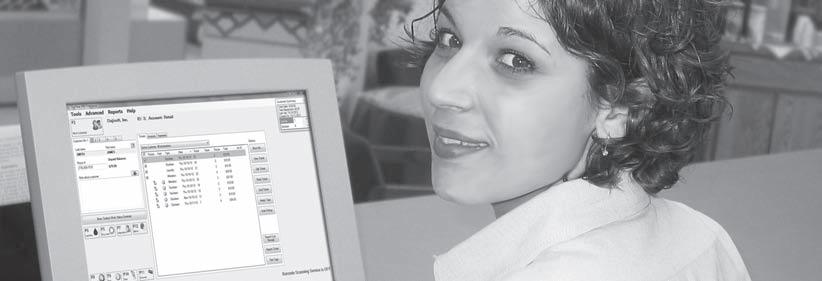





Irecently received a phone call from my friend, Norman Oehlke. Norm probably served IFI (now DLI, the Drycleaning and Laundry Institute) in most every technical position and wrote this very column until 2008. When he speaks, I listen. Closely. He still keeps a close eye on the cleaning industry and the changing solvents. We talked about the changes we had seen and the struggles facing owner/operators in today’s marketplace. We exchanged a few ideas and agreed that many cleaners have fallen victim to the concept of processing over pampering.
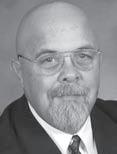
A symptom of this is that large companies have perceived there is profit in home dry cleaning kits due to consumer dissatisfaction with the quality of garment care available. Sadly, these dry cleaning kits have intimidated a number of cleaners, owner/operators who consider the end product of their service to be little better than the level of quality delivered by a rag, a bag and a home dryer.
In the past, there has been a place for those who just get by with going through the motions of processing.
To find past Spotting Tips columns or share this month’s with your colleagues, visit AmericanDrycleaner.com.

There will always be a place for those who do it well. The fact that you occupy a corner lot, with drive-around service and offer coupons/discounts in an attempt to maintain volume, is no guarantee of success.
Protect and enhance your monetary investment, by investing in continuing education for yourself and your employees. Instead of discounting your service, enhance it. Diversify to pamper your customers and their garments. The change requires a simple adjustment in attitude and the effort to acquire a working knowledge of fibers, fabrics, dyes, trim, and stainremoval protocol.
There are many owner/operators who will spend $12,000 for an additional piece of finishing equipment but refuse to spend $42 for an additional chemical tool to remove tannin stains. These same people will spend $1,000 to update software but refuse to spend $30 to provide a continuing education class for a cleaner/spotter.
The review of information presented at these seminars, and the new options for stain removal, will increase confidence and reduce potential claims. One often overlooked benefit to cleaning and spotting seminars is the ability to use the information learned to get one’s self out of problem situations that arise from mis-
classified garments and in-plant incidents.
It is the little things that can make a big difference. The addition of neutral synthetic detergent (NSD) to the steam spotting board is an inexpensive way to effectively improve stain removal. The addition of a sodium perborate soaking bath, in an old detergent bucket, can give new life to pastel cotton sweaters. The addition of an enzyme digester bath in an insulated cooler will reduce the time and effort needed to remove medium to large blood stains while improving quality.
These are just a few of the ideas that are presented at an industry seminar. Being able to remove redeposition and deal with an ink run can more than pay for the minimal fee structure of these seminars.
The chemicals at the spotting board are just as much tools of the trade as is a press or a boiler.
Silk garments are less tolerant of the pH of a spotter than polyester and cotton. One spotter does not get out all stains. There are times when the mild formula that is safe and effective on a fresh stain in silk and rayon is unable to remove the aged stain from a cotton garment. Your stock of spotting chemicals can easily be upgraded by ordering a single bottle (8 to 12 ounces) of a new/additional chemical tool. The $18 investment in a 12-ounce bottle will pay dividends if used sparingly.
You must explore all options to guide the success of your business. Being technically proficient at stain removal is one of those options, and it is an option that many of your competitors will not explore. They concede a niche in the marketplace to the operator who is willing to put forth the effort to not be a “me, too” cleaner. When you choose not to differentiate yourself,
(Photo: © iStockphoto/Romanchuck)you are giving potential customers your permission to go to the competition.
It always comes down to dollars and cents. Here is a real-world example for you to consider. A cleaner with potential gross sales of $5,000 per week is discount ing that figure by 10% through coupons and specials. In essence, the cleaner is “spending” $500 per week in an attempt to maintain market share. That amounts to more than $26,000 per year. A cleaner that is perceived as a little better than the competition can afford to upgrade the skills of current employees through continuing education. A cleaner that is perceived as a little better than the competition can boost the number of chemical tools available to its employees by commanding a nondiscounted fee structure.
The choice is yours. The start of a new year is the perfect time to think about your business model and your price point. Now is the time to look at how you want your potential customers to view your business. Consistent quality in stain removal is a sure way to make an impression and ensure repeat customers. O
Martin L. Young Jr. has been an industry consultant and trainer for almost 20 years, and a member of various stakeholder groups on environmental issues. He grew up in his parents’ plant in Con cord, N.C., Young Cleaners, which he operates to this day. Contact him by phone at 704-786-3011, e-mail mayoung@vnet.net.

The Textile Care Allied Trades Association (TCATA) has scheduled its 2013 Annual Management and Edu cational Conference for July 31-Aug. 3 at the Rancho Bernardo Inn, San Diego. Kim Shady of Laundrylux is con ference chairman. Jim Hericks of Fab ricare Supply chairs the Business Pro gram Committee, which includes Tim Grandy of Softrol, Shawn Martin of R.W. Martin & Sons, Steve Mathews of M & B Hangers and Angie Kalayjian of Norchem Corp.
JET Expo 2013, the laundry and dry cleaning trade fair in Paris, is sched uled for Oct. 11-14. The exhibition has been expanded from three days to four and will share its site with the Union of Hospital Laundry Service Providers. There will be training sessions each day. CINET plans to organize a confer ence on trends and marketing in the dry cleaning and laundry industry featuring international experts.
To learn more about the event, visit its website, jet-expo.com. O
Jan. 11-12 68th Annual New England Sanitone Licensees Meeting. To be held in Boston. Call 800-543-0406 for more information.
Jan. 17-20 Drycleaning & Laundry In stitute and National Cleaners Associa tion Five-Star Brainstorming winter con ference. To be held in Cancun, Mexico. Call 800-638-2627 or 800-888-1622 for more information.
Feb. 10-12 Independent Textile Rent al Association Mid Year Training Con ference. To be held in Arlington, Texas. Visit itra.us for more information.
March 7 Minnesota Dry Cleaners As sociation Training Seminars and Annual Meeting. To be held in Bloomington, Minn. Visit minnesotadrycleaners.org for more information.
March 15-16 Wisconsin Fabricare In stitute Drycleaners Annual Convention, Auction and Trade Show. To be held in Pewaukee, Wis. Call 414-529-4707 or e-mail bswingle@toriiphillips.com for more information.
June 20-22 Clean Show: World Educational Congress for Laundering and Drycleaning. To be held in New Orleans. Visit cleanshow.com for more information.
July 31-Aug. 3 Textile Care Allied Trades Association Annual Manage ment and Educational Conference. To be held in San Diego. Call 973-2441790 for more information.
Oct. 19-20 NCA Texcare Trade Show & Exhibit. To be held in Secaucus, N.J. Call 212-967-3002. O
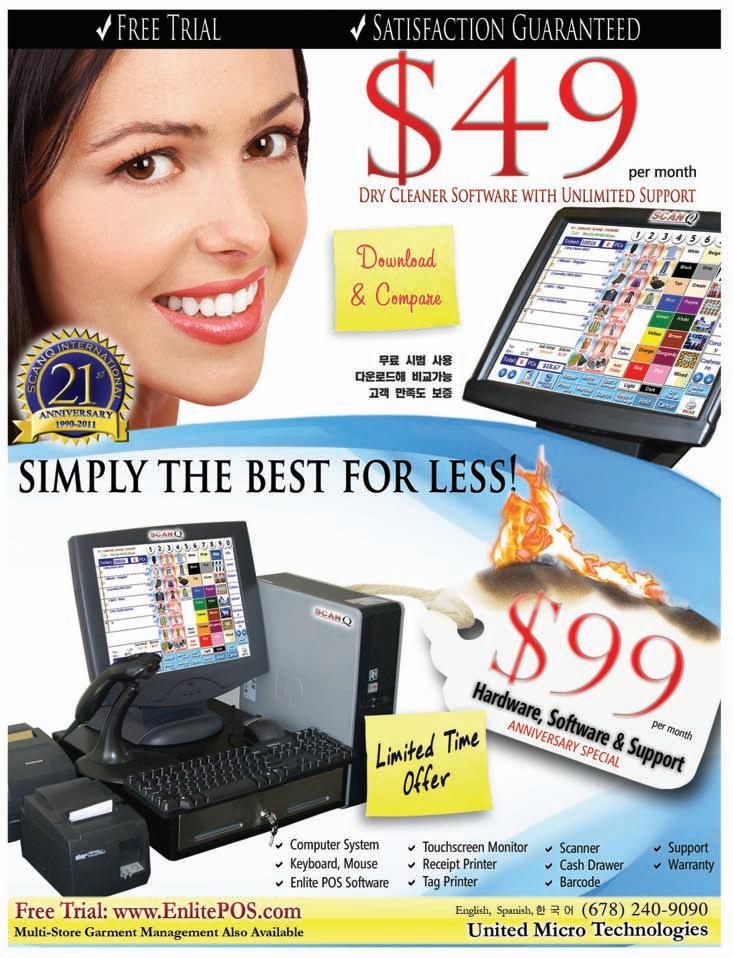
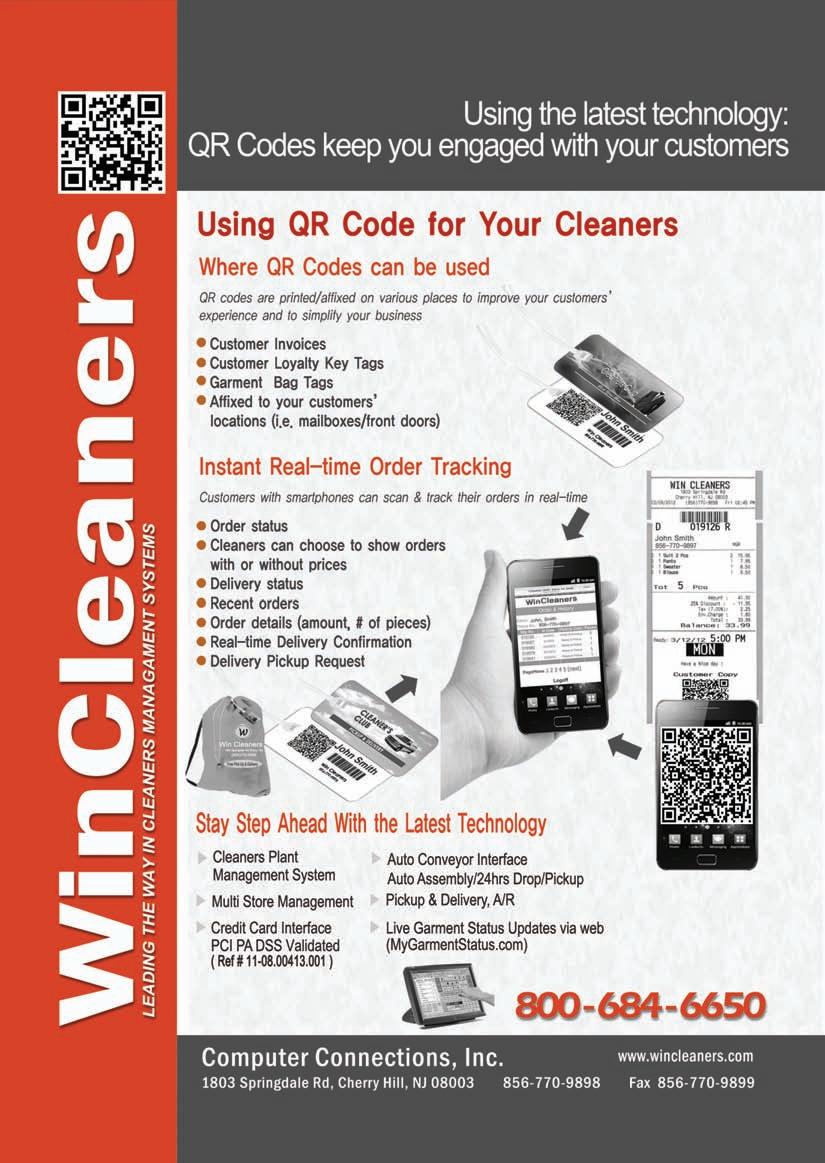
Often, your biggest asset can be your biggest obstacle. Your positive experience that led to past success can blind you to the current opportunities that exist with new approaches.
Some examples might be:
• Your free and clear plant store in a neighborhood that used to be a good dry cleaning location but now abandoned by your customers who prefer living elsewhere.
• Your tailor who previously attracted business but has now lost the ability to sew expertly.
• Your lead counter manager who is great with people but now resists computerization, route conversion, bar coding, or another important initiative.
• Your loyal office manager who proudly does things the same way he or she did them 20 years ago.
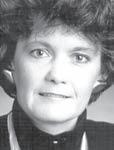
• You have made all the decisions up to this point, leading to successful growth, but you still want to make all the decisions in a much larger, more complex company. This is particularly stifling if you are bringing in the next generation of management.
How is it possible that experience can be an obstacle to success?
Consider some of the technological
changes since you began in the industry, whenever that might have been:
• 1966 — Handheld calculator
• 1976 — Personal computer
• 1991 — World Wide Web
• 1995 — DVD
• 1998 — Google
• 2001 — Apple iPod
• 2003 — Hybrid car
• 2004 — Facebook
• 2007 — Partial heart grown from stem cells
• 2009 — Hand-gesture-driven computer
• 2010 — Clothing in a spray can
• 2012 — Google Glass (wearable mobile computing)

Isn’t it reasonable that the way the industry was run when you learned the business may need an update?
Of course, you have been adapting to change all along. But have you updated your standard operating approach enough to prosper in the present business environment and beyond?
In our peer group management bureaus, there are always owners who are drawn to cutting-edge technology. Most of the others are happy to have them lead at the “bleeding edge” and then follow when a technique is proven. The object is to balance tests of new approaches with protection on the downside. That is why these efforts are called “tests” instead of “procedural
changes.” Full-blown implementation can follow at a safe distance after the pilot is proven.
The upside for the brave souls who lead the way is often a leap over the competi tion to a higher level of achievement.
A primary example is attracting new, younger generations to our “traditional” industry by communicating with them in the format(s) they prefer. For instance, the cleaners that immediately notify their cus tomers electronically when their orders are ready are enjoying “Old Inventory” per centages at one-fifth that of the average.
Electronic internal company communi cation is another example of successfully raising the level of staff performance re gardless of full-time or part-time status and work schedule. The messages can be inter active and consistent to everyone, thereby delivering the knowledge and information they need to be effective in a real-time en vironment. If you haven’t checked out ser vices like Yammer.com and Asana.com, you’re missing an opportunity to build the knowledge base, staff loyalty, employee buy-in, and camaraderie in your company.
A historically controversial subject is whether an operating plant store is more successful than a dry store. Although we can provide thriving examples of both, we can also provide many examples of stores that have been dried up but continued to grow in sales. Some of the highest-volume stores in the country have never been plants, attracting customers by their conve nience, location and outstanding service.
A well-publicized traditional choice is represented by the use of perc as the sol
vent of choice. The industry is reluctantly tearing itself away from this effective cleaning chemical, however, consumers have heard so much about it in negative media coverage that it does factor into their shopping habits.
Service displays in store lobbies have proven to be great selling tools that sup plant the passive, order-taker approach of most customer sales representatives. As an industry, we don’t even refer to the staff with the term “sales” but rather customer “service” representatives, so why should they think they are expected to sell?
In addition to rotating service dis plays of garments, route “doors” and home textiles, highly effective sales tools that prompt customer questions include flatscreen TVs with pre-determined, pro grammed messages. They are fully visible at eye level as customers stand at the coun ter, making the point difficult to ignore.
The diminished value of the old staple Yellow Pages and the many variations is apparent by looking at the recycle bins the day or week after they have been distrib uted. Exponentially greater instances of searches for services are occurring online.
Another controversial data point relates to the old adage that a low shirt price will be offset by the additional dry cleaning it will attract and, conversely, that raising the shirt price will result in fewer shirts. In tracking this data over several years, we have found that more often than not, a high er shirt price results in more shirts, not less. Many customers believe that it is necessary to pay more to get a quality shirt cleaned.
Another example of the impact of pric
ing strategy is the common pant special. In tracking pant and jean sales carefully, the result is often the same number of pieces but processed at lower profit.
Often, it is taken for granted that the route delivery and/or salesperson should be male, but tremendous success has been achieved by both genders. If door-to-door sales are part of your sales and marketing plan, consider the factor of perceived intimidation or fear and broaden your field of candidates.
In the area of packaging, twist ties are an ever-popular way to combine orders, but all of our customer focus groups have reported that consumers hate them. There are alternatives on the market.
Hiring great associates is always a challenge, but a newer technique that is resulting in better hires is the group interview.
The interaction between the candidates demonstrates their ability (or inability) to interact with other people as well as their leadership qualities (or lack thereof). They are much more candid and less rehearsed in this setting than in the classic one-onone interview setting, plus it is much more efficient for the interviewer.
These are just a few examples of adaptation to change that have been successful. Your experience is invaluable. Your great decisions based on your knowledge have led to your successes. Keeping your experience current and dynamic will lead to future triumphs for your company. O
Methods for Management (MFM) Inc. has served the dry cleaning and laundry industries with afford able management expertise for improved profit ability since 1953. You can reach Diana Vollmer at dvollmer@mfmi.com, 415-577-6544.
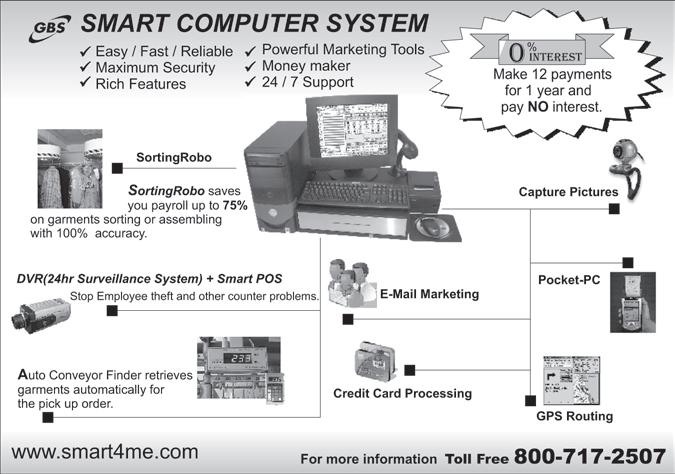
As the new year gets under way, those in the laundry and dry cleaning industry who are planning to attend Clean 2013 this summer can now register for the event and reserve their hotel room in the Big Easy.


Scheduled for June 20-22 (just three days this year instead of the traditional four) at the New Orleans Morial Convention Center, Clean 2013—officially the World Educational Congress for Laundering and Drycleaning—is touted as the world’s “largest exhibition of commercial laundry, dry cleaning and textile services equipment and ancillary products,” according to Riddle & Associates, the exhibition’s organizer.
Pre-registration is set at $99, with a deadline of May 31. After that date, attendees will have to register on site for a fee of $149 per person.
Attendees will have a valuable hands-on opportunity to learn about new products and gather the latest information about industry trends, says John Riddle, president of Riddle & Associates. “You will see the newest equipment, learn about new services, see working demonstrations
and have access to outstanding industry education. In today’s world of electronic communication, it is nice to have the opportunity to communicate with someone eye-to-eye, face-to-face, and talk with them about industry issues.”
In addition to product exhibitions by hundreds of companies, Clean 2013 will also play host to several educational sessions presented by the five major industry associations sponsoring the overall event. The Association for Linen Management (ALM), Coin Laundry Association (CLA), Drycleaning & Laundry Institute (DLI), Textile Care Allied Trades Association (TCATA) and Textile Rental Services Association of America (TRSA) will host educational sessions that are open to all registered attendees.
“Each association supports its members with education and other valuable services to help them grow and protect their businesses,” reads the Clean 2013 website. “The associations develop and offer seminars on topics of interest to their respective segments.”
To assist attendees with accommodations, the Clean Show Housing Bureau
has been established and offers discounted rates ranging from $109 to $315 per night at 20 area hotels.
In addition to general housing for attendees, five properties have been designated as “headquarter hotels” for the associations sponsoring the event, for those who wish to stay with other attendees and exhibitors from their segment of the industry.
A note on the event website reads, “You may be able to find lower rates at official Clean Show hotels by booking through other services, but you may not get the same product in return.”
A complimentary shuttle-bus service to and from the Morial Convention Center will be offered during the June event. The dedicated service will make stops at all headquarter hotels and within two blocks of other official Clean 2013 hotels.
Hotel reservations must be made by May 17 through the Clean Show Housing Bureau to receive the discounted rates.
Official Clean 2013 hotels include:
• Astor Crowne Plaza (CLA)

• Best Western Plus St. Christopher
• Chateau LeMoyne French Quarter
• Courtyard New Orleans Downtown/ Convention Center • Hampton Inn Convention Center • Hilton Riverside • Holiday Inn French Quarter • Courtyard by Marriott, Downtown/ Iberville
• Loews New Orleans Hotel • Marriott Convention Center (TCATA) • Marriott New Orleans (TRSA) • Monteleone • Omni Royal Orleans (ALM) • Ritz-Carlton, New Orleans • Royal Sonesta (DLI)

Sheraton New Orleans
Springhill Suites Convention Center
W Hotels New Orleans
Westin • Windsor Court
One other benefit that attendees will reap, says Riddle, is the sense of camaraderie and connection among the various businesses and organizations in the industry. “It’s a great chance to renew old friendships and make new ones.”
To learn more about Clean 2013, including how to register and make hotel reservations, visit www.cleanshow.com. O

You open a letter from the IRS: You are being audited. A shock goes through your body. Your hands begin to shake. The timing couldn’t be worse. You’ve got a half-dozen projects going on. “Why me?” you ask. Then your mind pictures what it would be like to languish in jail.
Don’t panic. An audit doesn’t nec essarily mean there is suspicion that you aren’t being forthright. A portion of all business audits are ran dom selections. Furthermore, an audit doesn’t mean that you will have to pay a large bill.
About 25% of audits result in dismissal. Satisfy the auditor and you probably won’t be bothered for many years.
Having said that, there could be cause for alarm. If you are deliberately inflating expenses or understating revenue figures, the auditor will seek to discover these untruths. Reducing revenue is considered fraud and could result in criminal prosecution. Overstating expenses is bad, but one could argue that the books were messed up, the bookkeeper was incompetent, the computer system malfunctioned, or that you just didn’t understand what was required. In other
To find past columns from Howard Scott or share this month’s with your colleagues, visit AmericanDrycleaner.com.

words, it is easier to make a case for overstating expenses than for understating income.
The simplest audit is a correspondence audit. You are asked to clarify one or two issues. Responding with a letter that includes proof backing your position will end the inquiry. Office audits require meeting with an IRS auditor.
Most office audits specify areas of concern. Speak frankly to your accountant or CPA. Together, evaluate the magnitude of the audit. If it is over a few areas, and your books are in order, you might want to handle the matter yourself.
If you prefer, your accountant can represent you. Of course, the accountant will want to be paid. Many preparers start their billing at $200 an hour, and that includes preparation time and representation. Any lawyer, accountant or enrolled agent can represent you, providing he/she did the taxes of that year’s return.
“I prefer to do all the talking,” says H&R Block’s Stuart Campbell, a longtime audit representative, “although I involve the client a bit to establish credibility.”
An audit is always conducted at the convenience of the person being audited. You decide whether you want to meet at the auditor’s office, at home,
or at your place of business. It mostly depends on how methodical you are.
Organize your records. Make sure you can back up every figure on your tax return. That means making copies, updating logs, and putting everything in sequential order. If there is no backup, prepare a written explanation of the deduction. If the books aren’t in order, get them in order. This task involves a lot of work, but it will make you knowledgeable about your situation.
Do not go into the meeting acting like an angry bull. Remember, you’re dealing with a human being. But at the same time, do not be a fawning sycophant begging for mercy. Be professional and business-like.
Let the facts and figures do the talking. You’ll go over item by item. The auditor might say that an expense is disallowed.
Do not argue. Go on with the proceedings. Let’s consider a few examples. If you have no backup, come up with an explana tion of why there is no documentation. For example, you had work done on your front counter, but do not have the receipt because the contractor disappeared after being paid. Suggest that you could try tracking down the contractor. The auditor might go along since it is a reasonable expenditure.
If your cost of supplies is way above the regional average, say 15% of revenue vs. the average of 11%, come up with a plausible explanation. Your prices are extraordinary low, which brings up the percentage. You lost a lot of supplies in a basement flood, and you had to replace everything. You believe in high quality, and that pushes up your cost percentage. Formulate an argument that sounds
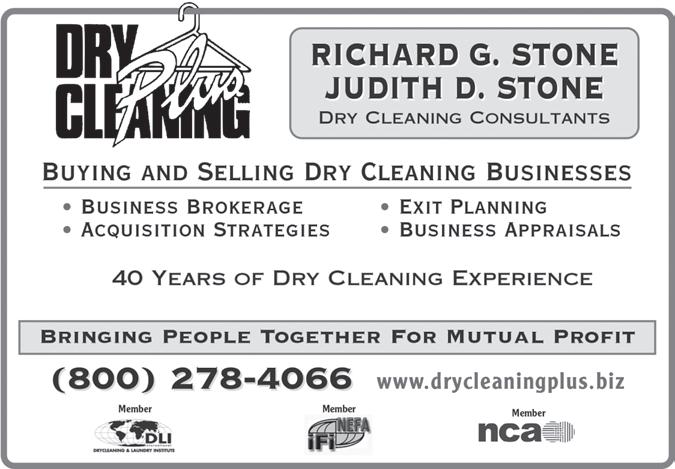
plausible and is hard to reject.
If you purchased an at-home computer for $1,400 that you say is for business use only but the auditor argues that computer use can’t be limited to business only and will only give you a $700 Section 179 deduction (50% of cost), don’t argue. Let the $700 go. He’s being a stickler. Don’t fight the small potatoes.
Don’t try to outsmart the auditor. Come clean with all major discrepancies up front, especially revenue figures. Most likely, the auditor has the proof in the form of bank statements.
Don’t ignore IRS letters. One opera tor’s decision to do so resulted in the IRS assessing him $135,000 based on what the agency figured for his obligation. Divorce, bankruptcy and home foreclosure followed.
At the end of the session, the auditor will add up the adjustments and disallow ances and come up with an assessment. Any penalties and interest, which could be hefty if being audited from two or three
years back, will be tacked on. It is possible to counteroffer, which is called an offer in compromise. The auditor will be more inclined to go along if you are close to insolvent. But you never know when he or she will be willing to bend. It also helps your position if you can pay off the liabili ty right away. If you can’t, you can arrange a payment schedule over time.
You may challenge the assessment, dealing with an appeals officer, and then you may go to tax court. If there are legal points at stake, you might hire a tax attor ney, who might find precedence that could sway the judge. On the other hand, it might be less stressful to swallow hard, pay the bill, and make sure you keep detailed books in the future. O
Howard Scott is a longtime industry writer and dry cleaning consultant, and an H&R Block tax prepar er specializing in small businesses. He welcomes questions and comments, and can be reached by writing Howard Scott, Dancing Hill, Pembroke, MA 02359, by calling 781-293-9027 or via e-mail at dancinghill@gmail.com.
Round Numbers — Using round num bers—$8,000 for a presser instead of $7,959—hints that you are not paying at tention to figures.
Big Change from Last Year — If your labor cost was 38% last year but has now gone up to 49%, you need a good expla nation of what changed. Auditors look for percentage shifts.
— The reason you have to code your business—the six-digit num ber—is that you are being categorized with fellow operators. Auditors love to make comparisons. If your cost of doing business
is much higher than the industry average, auditors will want to know why.
High (Above the Norm) Audit Scores
— The IRS has created a secret list of cri teria, including low gross profit margin, high auto expense, high travel and entertain ment, and little or no profit, upon which audit selections are based. If your overall number is up, you risk being audited.
Messy and Disorganized — A messy, hastily assembled return could tip auditors off that you aren’t thorough. You can’t be disorganized with it comes to the IRS.
Chosen at Random — Your business was randomly selected to be audited. O


It was a Sunday morning, so it was fitting that dry cleaning industry veteran Michael Nesbit would open his Fabricare educational seminar with a Bible verse.
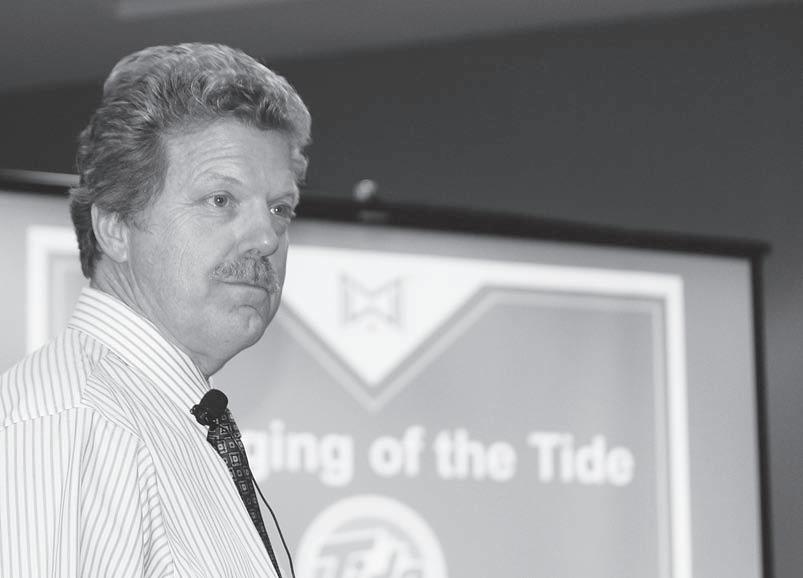
Quoting James 3:1, he said, “Not many of you should presume to be teachers, my brothers, because you know that we who teach will be judged more strictly.”
“That means, first of all, when I look in the room here, there’s a lot of guys a lot better in the industry than I am,” he says. “And I’m humbled to be here.”
Nesbit, who heads Houston-based MW Cleaners, the dry cleaning division of The Men’s Wearhouse®, had a great deal of insight to offer based on years of hard work and industry success.
“I want to tell you that the industry’s not dead,” he says. “There is still a lot of opportunity in what we do.”
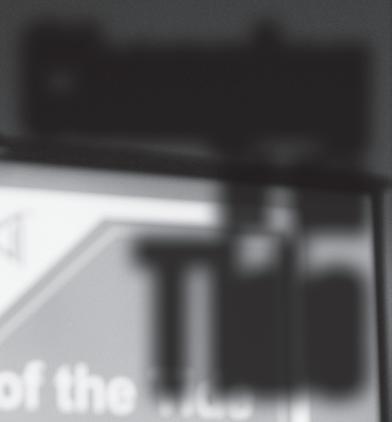
And so he began discussing The Changing of the Tide.
GAINING EXPERIENCE. Nesbit’s work ethic formed early as he started his first business, a parking lot cleaning service, when he was 16. By the time he was a high school senior, he was managing a group of people in cleaning 200 properties in Houston.
Dry cleaning entered his life when, while attending Sam Houston State University, he was called home to help at a dry cleaning business when his stepfather suffered a heart attack. He fell in love with the business and soon was looking to invest his savings into a dry cleaning franchise.
Eventually, Nesbit joined forces with a financial principal to start Nesbit’s Cleaners in 1978. The business grew from one
store to 22 locations and three home pickup and delivery routes in 2003. Its newest plant at the time won Plant of the Year honors in an American Drycleaner Plant Design Awards contest for its innovative design and drive-thru concept.
The Men’s Wearhouse, a Houstonbased company wanting to enter the dry cleaning business to complement its men’s dress apparel, identified Nesbit as someone who could run such a business. But Nes bit’s Cleaners was well established in the local community and he had no interest.
“But they kept coming back to me, the second time, third time, fourth time, and every time they came back to me, they raised the number.” They recruited him to grow their new brand nationally.
And so it is that The Men’s Wearhouse acquired Nesbit’s Cleaners and Nesbit became president of MW Cleaners. Under his direction, MW Cleaners has expanded to 37 Houston locations, including 22 home pickup and delivery routes. Its nine production facilities and 350 employees produce about 6 million garments annually. Annual revenues for 2012 were expected to exceed $26 million.
MW Cleaners also offers a wedding gown preservation service business to business. Nesbit’s son, Kyle, runs it. At the time of his presentation, it expected to preserve 45,000 gowns in 2012.
“We are the largest dry cleaner in the world,” Nesbit announces. “We produce about 20 million pieces annually. Six million of that is retail, and the balance of that would be tuxedo cleaning.”
While The Men’s Wearhouse and MW Cleaners are part of the same family, their business models are quite different, Nesbit says, and it’s taken the apparel retailer
some time to figure that out.
“Their customers come in once a year or less, our customers come in every two or three weeks,” he says. “We know their names, we know their dogs, we know everybody. … They rented 6 million tuxedoes last year that represented almost $400 million in revenue. I cleaned 6 million pieces and did $26 million. … We have to handle a lot more pieces than they do, because of that revenue per piece.”
Understanding that dry cleaning is a business driven by location, it’s been Nesbit’s task to grow MW Cleaners with less real estate. “Today, our business is almost 40% home pickup and delivery, from 3% seven years ago when they bought it. If I can figure out a way to do home pickup and delivery, and mitigate the amount of real estate, then I’m out of Houston.”
TURN THE TIDE. The arrival of Tide Dry Cleaners and its expanding franchise system has gotten a lot of attention and may even sparked fear in some operators, Nesbit says. “Tide brings new levels of sophistication to the market. I don’t want you to be scared, I want you to be prepared, not just for Tide but for the competitor around the corner.”
Tide has invested a great deal of money doing market research in major cities throughout the country, according to Nesbit, and they’ve learned three things about the average dry cleaner: “We’re dark, we’re dirty, and we suck. That’s what consumers told them. What did that spell to them: opportunity!”
The market is changing, and there are different competitors in the marketplace. How do you get a bigger piece of a smaller pie?
What are the four reasons why customers choose a cleaner? It’s convenience/location, customer service, quality and price, according to Nesbit.
“Why the hell do we keep focusing on price?” he asks. “I come to these meetings and you know what I hear about? Groupon. … At the end of the day, there is no magic pill. It’s about getting in there every single day. This is a hard, tough business, and we’ve just got to keep doing it and doing it right.”
Of MW Cleaners’ 37 locations, 28 have drive-thrus. Nesbit places a lot of emphasis on this service, because the No. 1 reason that customers choose a cleaner is convenience. “As leases come up, I’ll move to another spot and put in a drive-thru, because I’m going to get a 20% lift (in business),” he says.
Having a good location is important, but don’t fall into the trap of opening a dry store just because you can get a good deal on the rent. And you’ve got to treat a dry store with as much care as you treat your plant stores. “We go put a dry store in because it’s got cheap rent, then we put ‘one-tooth Mary’ in there,” Nesbit says. “She’s not good enough to work at the plant, but we’re going to put her (at the counter)? It’s a self-fulfilling prophecy.”
MW Cleaners routinely uses direct mail to reach prospective customers. “We pick a polygon around our locations. Every month, I’m sending out coupons to a third of that polygon. When the (end of the) year comes around, I’ve touched every one of those non-customers.
“And I don’t wait for business to get bad before I do marketing. I consistently do marketing.”
American Drycleaner, January 2013
Once MW Cleaners gets a customer through a special offer, it sends them another offer via e-mail. As long as this customer responds to the offers, MW keeps sending them. Once three offers have gone unused, it discontinues sending offers to that customer.
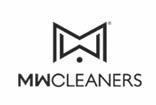
“What I don’t want to do is discount to everybody. Price is in the top four, price is up there. But it’s not in the top three, and I’d rather focus on the top three.”
Cleaners often speak of needing to improve customer service, but they don’t give their employees guidelines for what good customer service looks like, Nesbit says. MW Cleaners uses an acronym—SMILE: S Speak and acknowledge a customer as soon as they enter the door. Say the customer’s name frequently. Speak first and last. Speak and acknowledge a customer, even if you are busy with someone else. Smile and be friendly.
M Make eye contact. Make the customer experience as pleasant as possible. Make the customer feel important.
I Image must be maintained with clean, neat stores and well groomed, properly uniformed employees.
L — Listen to the customer’s request, complaints and concerns. Listen, listen, listen!
E
Exceed customer expectations!
To be its very best, every business has to examine itself through a consumer’s eyes and provide the kind of service a customer expects. “There’s no magic solution to what we do,” he says. “It’s really about focusing on the core competencies of our business. And it’s day in, day out.” O




The E-Series 55-pound-capacity washer-extractors from Continental Girbau now offer a single-phase option, enabling the high-performance machines to be installed at locations with limited utilities.
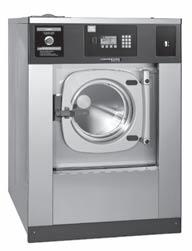
Now, nearly the entire E-Series line of high-speed, soft-mount washers—including the 20-, 30-, 40- and 55-pound capacity models—offer single-phase power. The washers can be installed without bolts and special reinforced foundations, allowing for quick installation and same-day use, the company says. The E-Series consumes approximately 10 to 20 gallons less water per load than traditional hard-mount washers, the company reports, and offers extract speeds reaching 387 G-force.
The series also features two microprocessor controller options. The Logi offers eight modifiable phase-to-phase programs that feature up to nine baths. The Inteli offers 20 modifiable phase-tophase programs, and up to 79 owner-programmable options.
Continental Girbau | 800-256-1073 | continentalgirbau.com
Hi-Steam now offers a new mini boiler with iron that is designed to provide all-day, non-stop pressing, according to exclusive dis tributor European Finishing Equipment Corp.

The mini boiler, called the MVP-35Auto, comes in a stainless steel cabinet, with an automatic pump water feed. Operators can add water to the 2.7-gallon portable tank and continue pressing without having to depressurize the boiler first.
The MVP-35Auto plugs into a standard 110-volt, 15-amp outlet; uses ordinary tap water, requires little maintenance, and supplies 40 pounds of steam pressure, the company explains.
An optional steam spotting gun is also available for the new unit.
European Finishing Equipment Corp. | 888-460-9292 | hi-steam.com
Tingue, Brown & Co. recently introduced its TingueKleen line of flatwork-ironer cleaning cloths. With five different styles, the cloths feature a design that combines an abrasive mid-section for removal of accumulated lint and grime with a soft, padded trail ing edge that captures loosened debris and leaves an ironer ready for operation.
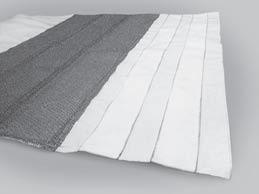
The leading edge indicates the proper orientation and direction for feeding and is offered with a designed-in cleaner pocket.
As the foundation of a cleaning and lubrication schedule, the cloths are used at the start of each shift in conjunction with proper waxing to help pro mote peak performance and optimum finish quality.
The product line includes the Premier, Supreme, Regular and small Cylinder Pad and large Cylinder Pad styles to accommodate small- and large-roll flat work ironers and cylinder ironers from any manufacturer.
Tingue, Brown & Co. | 800-829-3864 | tinguebrownco.com
Crossover, the commercial-standard small-chassis washer from Wascomat, is CEE Tier III-qualified for the highest level of energy efficiency, the company says.
Tier III is the highest among three levels of energy efficiency rec ognized by the Consortium for Energy Efficiency, a non-profit public benefits corporation that works to develop initiatives for its members (including U.S. and Canadian energy offices, utilities, research and environmental groups) to promote the manufacture and purchase of energy-efficient products and services.
Crossover was introduced last year after four years of inten sive development, Wascomat says. Products in the line include a 22-pound-plus standalone washer, dryer, and stack washer/ dryer combo, all engineered specifically for the demanding laundry environment.
Crossover is built to last more than 15,000 cycles, more than double the life of appliance-type front loaders and top loaders, and offers 300 G-force highspeed extraction, the company says.
Laundrylux | 800-645-2205 | laundrylux.com
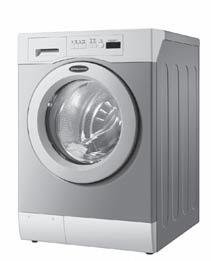
Rainbow
Oxford, Miss.
He rron Rowland really didn’t want to sell the corner location his Rainbow Cleaners occupied. For months he politely declined the inquiries of a real estate developer representing a major drug store chain. The chain kept looking for a suitable site in Oxford upon which to build but always came back to Rainbow’s corner. Eventually, Rowland agreed to sell the property and relocate his business. He promptly set into motion a
plan to build a better, brighter plant. Having seen his business operate out of what once had been a steakhouse, Rowland was excited to take advantage of the opportunity to build new.
He invested in excess of $1 million to design and develop a 5,000-square-foot “building that’s purpose was to function as a dry cleaning operation.” That highvisibility plant, located just seven blocks from Rainbow’s previous lo-

cation, earned the Grand Prize for Best Plant Design in the 52nd Annual American Drycleaner Plant Design Awards.
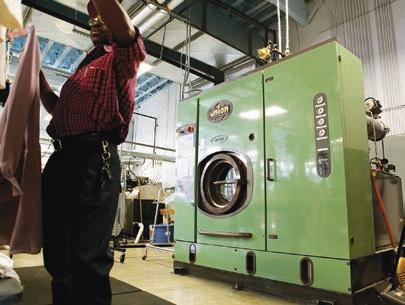
HOME TO OLE MISS. Rainbow Cleaners has served Oxford, home to the University of Mississippi, or Ole Miss, since 1970. Rowland is an Ole Miss graduate, hav ing received a business degree there in 1985. He recalls that Rainbow always stood out among the nine or 10 clean ers that once served this community.
I t was originally located in the city square but as the retail environment changed and being located downtown became less convenient for custom ers, Rainbow Cleaners was relocated to a defunct steak house on Jackson Avenue, a major east-west thoroughfare that borders the Ole Miss campus, in 1996.
When Rainbow’s founder decided to retire several years later, Rowland and wife Cynthia acquired the dry cleaner in 2003.


They made no immediate changes to the business that had experienced growth during what Rowland calls the “Eli era.” The Ole Miss football program had risen to prominence in 2000-2003 on the right arm of quarterback Eli Manning, and the community and the university had grown because of it.
A few years after Manning went pro, Rowland upgraded the business with ▲
Opposite: A colorful LED light show illuminates the front of Rainbow Cleaners. Right, from top to bottom: the pressing and finishing area; the boiler room; a computerized order assembly workstation; dry cleaning machine.

a new dry cleaning ma chine and some press es. “I had no intention of moving,” he says. “My plans were to con tinue to improve the lo cation and the property, but I was approached by a developer for CVS Pharmacy. I was not in terested in moving, but after an 18-month pro cess, we finally reached an agreement that I would relocate.
“If I was going to go through this, instead of making a cleaner fit in a Bo nanza Steak house building, we had an op portunity here to start from the ground up.”
R owland wouldn’t have to look far to find a new location. Just up the road, “cattycorner” to the west ern entrance of the Ole Miss campus, sat a vacant lot. The proj ect that had been planned for the site had stalled when the economy slowed down.
Owner
Construction on the new Rainbow Cleaners commenced there in June 2011, and the business began transi tioning in November 2011. The move was completed in early 2012.
DESIGN DETAILS. As Rowland worked with an architect to develop a plant layout based on positioning of certain equip

ment, he considered switching to a SPOT Business Systems computer sys tem. When he asked the software com pany for references, it recommended he contact Deluxe Cleaners in Birmingham, Ala.
Upon talking to the principals at De luxe Cleaners about his software needs and describing the type of build-fromscratch project he was undertaking, they suggested he seek out Sheldon Bray, a dry cleaning consultant with


Cleaner’s Mentor Consulting out of Nashville, to review his plan.
“I picked up the phone and I called him,” Rowland says. “During those conversations, I sent him a copy of the plant layout, which was sufficient, but Sheldon presented a plant layout that had a business model with it. We scrapped that first plant layout, and I handed it over to Sheldon.”
The drive-thru at the previous loca tion was in the back of the building, and wasn’t highly visible or accessible.
“I wanted to create a drive-thrudominant store that not just offered drive-thru but almost attracted the cus tomer to the drive-thru rather than the counter,” says Bray, a fourth-generation dry cleaner himself. “Wanted to be able to wait on a lot of cars at once.”
Where the previous plant had used perc for dry cleaning, Bray advised
Rowland to switch to hydrocarbon dry cleaning plus wet cleaning, which he did.
The previous location was confining, says Rowland, with little natural light reaching the back of the business. He really wanted a plant that embraced open spaces and let the light shine on the dry cleaning work his employees was doing.
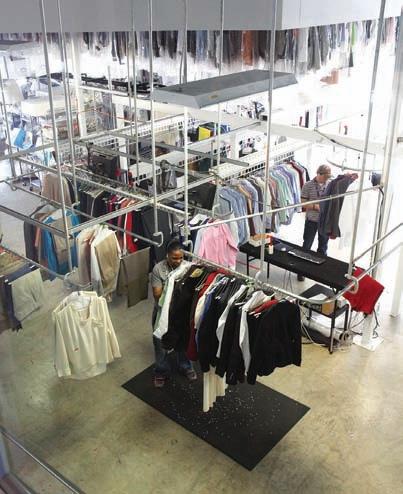
“Also with that, you have times where a customer says, ‘You all burned my clothes,’ or claimed we did some thing to them. They couldn’t see what we were doing. It’s one thing to say, ‘No, we’re not.’ Here, I’m able to say, ‘No, come take a look. That’s not the process of it.”
Bray likened it to putting on a show. “We didn’t want to hide the plant and the actions behind the wall. We wanted to bring that out to be exposed. So we chose the Unipress double buck shirt unit as the most exciting piece of equip ment, if you would, and we put that front stage in the window.”
And if that doesn’t grab the attention of passersby, the light show outside certainly does. The Rainbow Cleaners exterior is equipped with computer ized LEDs that project lights of different colors up the face of the building and under the white canopy. They often rep resent the shades of a rainbow.
But on Ole Miss game day, you can expect to see red and blue. Rain bow also has light shows representing school colors of the Oxford and Lafay ette County high schools, plus there’s red and green for the Christmas season.
Rowland wanted to incorporate a rainbow of colors into the new build
ing, but he wasn’t quite sure how to go about it. Colored window panes were consid ered at one point, but proved to be cost-prohibitive.
Then, during a family trip to New Orleans, he noticed a ho tel that featured color-changing lights on different floors. He Googled the hotel and discov ered the term “computerized LED lights.” He soon found a vendor and struck a deal.
“I actually gave up a back up generator to put the lights on the building, and it was a good decision.”
TAKE A TOUR. Rowland guesses he’s taken at least 10 curious customers on tours of the facil ity in the year it’s been open.
“This is, first and foremost, a production facility,” he says. “When you walk in, it’s a limit ed amount of space … it’s not more than 300 square feet at the front counter for our cus tomers. Instead of us standing behind the counter, we walk around and stand side by side with the cus tomer and use a touch-screen system right there at the counter when they lay the clothes out.”
Don’t want to leave your car to collect your dry cleaning? No problem at Rainbow Cleaners, where staff greet customers from one of two drive-thru doors on the side of the building.
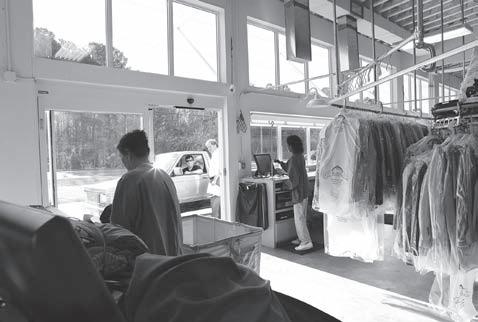
sisted-assembly areas, then there are the drive-thru doors.
Just like the visibility of the produc tion area, Rainbow wants its customers to be able to see what’s being entered in the computer and how their clothes are being marked for handling, he says.

Next are some White Conveyors racks positioned next to the dry clean ing assisted-assembly and laundry as
“ We’ll explain to them, particularly if it’s a first-time customer, that they’re welcome to park and come in, but if they’re busy and want to pick up, they just enter on the side of the building and we’ll walk out to their car.”
All of the finishing and tensioning equipment, the majority of which hails from Unipress and Forenta, is centrally located in the plant. Two screw convey ors push finished garments along slick rails to inspection stations.
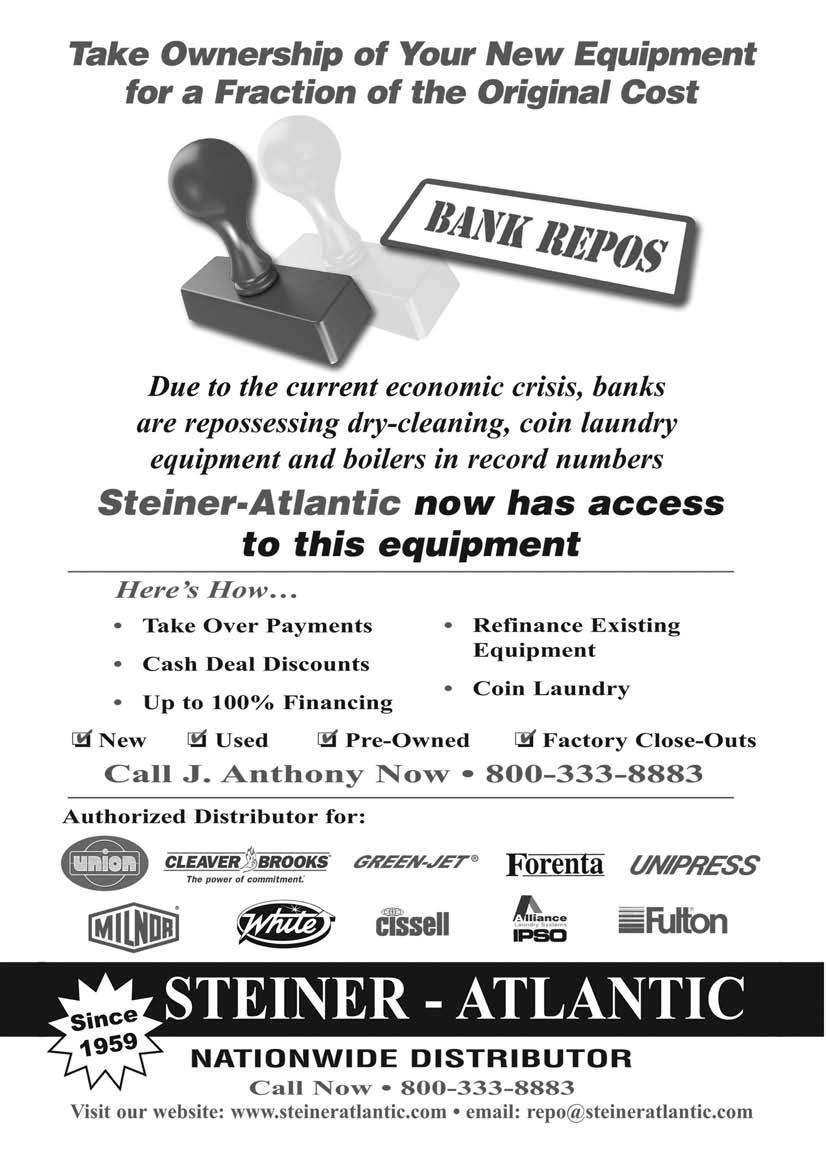
Along the south wall is laundry and wet cleaning equipment from UniMac and Wascomat. Rowland says wet cleaning now accounts for 10-15% of Rainbow’s volume. A Continental Gir bau flatwork ironer enables the busi ness to finish tablecloths and linen for the university. Also on that wall is a 60-pound Union dry cleaning machine. Boiler room equipment comes from Ful ton, Rema Dri-Vac, Quincy and NATCO. While Rowland is proud of his plant, his pride really shines through when talking about his 23 employees (15 are full-time). Manager Billy Phillips learned production management while work ing many years at a local electric motor plant. Brenda Kilpatrick, daughter of the original owner, has worked for Rainbow for 27 years. Willie Mae King is in her 25th year in production, and Brenda Starks is known far and wide as the
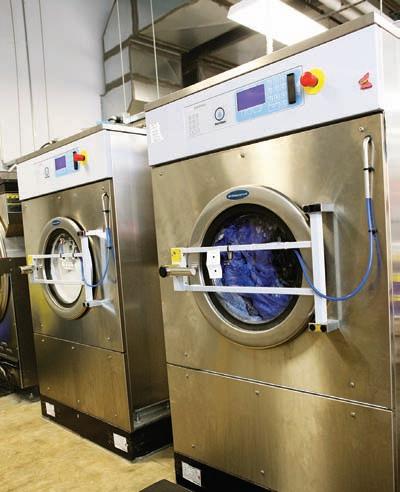
“drive-thru lady.” Finally, there’s Mable Jones, who alternates between press ing, inspecting and sewing so every finished garment looks its best.
“We are a completely different busi ness than we were down the street,” Rowland says. “I attribute a good portion of that to Sheldon. He gave us a model with which to manage this business, one being the lot system and the plant being designed to support that lot system.”
W hat has the new plant meant to Rainbow Cleaners? It saw a 30% in crease in overall business and piece counts using fewer labor hours in the first year, according to Rowland.
“ We’re set up to grow, and that’s job security for my employees. … Rain bow Cleaners has been in operation for 42 years, and I think we could be in operation for another 42, with where we are.” O
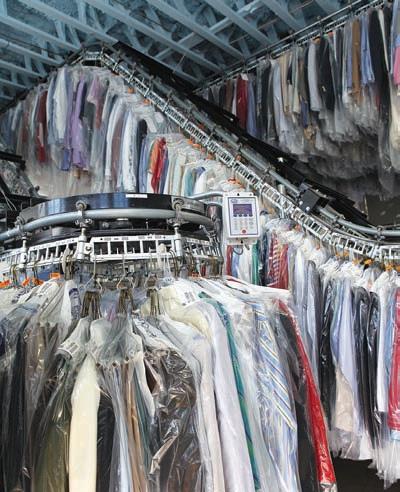
Skylark Dry Cleaning St. Paul, Minn.
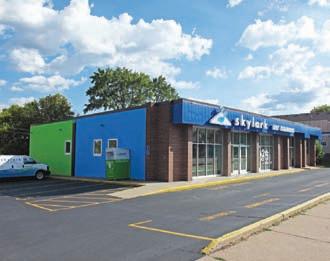
Skylark Dry Cleaning, owned by Andrew Gaspard, started with route service from a plant in an industrial area. When looking to expand, the business purchased a freestanding building to add a retail store front. Skylark offers dry cleaning, wet cleaning, alterations, in-car service, a 24-hour lobby with lockers, and retail sales from soda to soap.
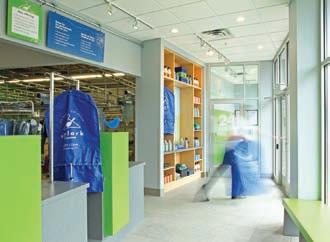
The production floor in the 6,236-square-foot plant features a Union dry cleaning machine using GreenEarth, a Micell CO 2 dry cleaning machine, Wascomat wet cleaning equipment, and Unipress finishing and tensioning equipment and shirt units. SPOT Business Systems software is utilized for computer-assisted assembly.
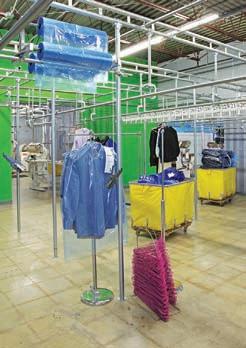
Skylark employs nine full-time workers and generates $14,000 in weekly sales.
Sheldon Bray of Cleaner’s Mentor Consulting created the plant layout. McMonigal Architects served as project architect. O

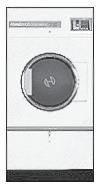

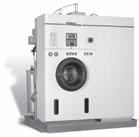
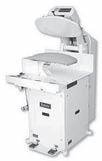





The newest Lapels plant from Massachusetts-based franchisor Next Step Franchising features granite counters, custom cabinetry, chandeliers, pendant lighting, French doors, etched glass, crown moldings, and a fully separated call area from the on-site plant.
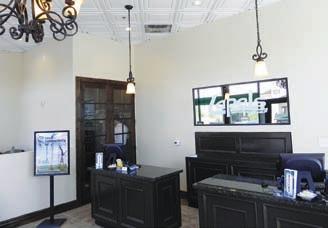
Lapels offers dry cleaning, shirt service, on-site tailoring, leather/suede care, shoe repair, 24-hour drop-off, heirlooming, and same-day service, pickup and delivery.
The air-conditioned production area in the 2,200-square-foot facility includes a Firbimatic hydrocarbon dry cleaning machine, Wascomat wet cleaning equipment, and Forenta and Unipress finishing and tensioning equipment. Boiler room equipment is by Fulton and
Ingersoll Rand. The plant utilizes DCCS and SPOT Business Systems computer software.
This Lapels location employs 12 fulltime-equivalent workers.
Next Step Franchising designed the plant layout, and Mike Marden, Marden Design, was architect. O

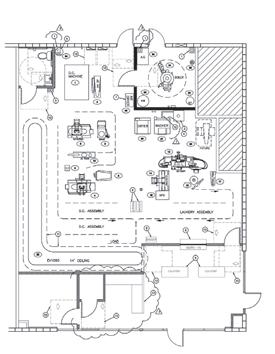
The newest location from Texasbased Comet Cleaners Franchise Group can be found in a fast-growing part of Lubbock. The clean, modern store, which covers 3,500 square feet, features two drive-thru lanes with a canopy. Friendly, professional staff greet cus-
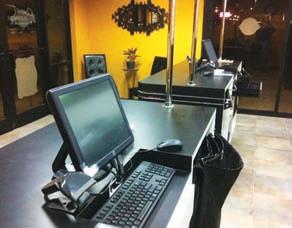
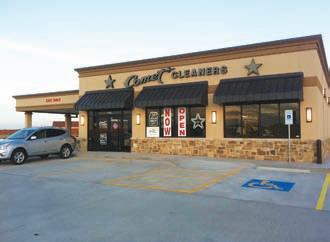
tomers with bottled water.
Comet Cleaners offers dry cleaning and laundry services, alterations, and wedding gown preservation, as well as cleaning of household items and drapes. Same-day service is available until 2 p.m. on weekdays.
The production area—customers can see the plant from the front counter—includes a Union dry cleaning machine, Wascomat laundry equipment, and Unipress and Forenta finishing and tensioning equipment. Boiler room equipment is by Lattner Boiler. The plant utilizes DCCS workstations.
Comet employs 13 full-time-equivalent workers and generates more than $10,000 in weekly sales.
Owner Ron Caffey designed the plant layout, Mike Lowe was architect, and Gulf States Laundry Machinery was the project’s equipment distributor. O

L
ately, I’ve heard the phrase “perception is reality” used in several different, unrelated conversations. I called Diana Van Brunt of Westbank Cleaners, Austin, Texas, to ask her what she meant when she used it.

It’s how the customer interprets someone’s actions or words, she says. “If you ask someone to wash the dish es, they may choose to run the dish washer, or wash them in the sink, or use disposable plates. It’s the perception of washing dishes.”
I’ve reviewed tens of thousands of mystery shop reports and have seen how a single experience—such as computers at the front counter not working—can alter a customer’s perception.
Mystery Shop Report: The customer service representative (CSR) greets the customer with a smile. He says that the computers are being worked on and that he is taking extra special care to be sure that her silk blouse will be taken care of, the gravy stain will be removed, and it will be ready on Wednesday. He gives her the handwritten receipt, noting the stain and the day the blouse will be ready.
Perception: The customer thinks the CSR did a fine job and had a positive attitude.
Mystery Shop Report: The CSR sighs deeply and averts her eyes as the customer approaches. She then explains that without her computer running, it’s not going to be easy for her to check in the silk blouse. If the customer must drop it off, she will hand-write a receipt, but handwritten receipts are just that. “Well, I will do the best I can,” the CSR says. “By the way, are there any stains?”
Perception: The customer is concerned that her $300 silk blouse will be cleaned correctly. In fact, she is worried that she may never see it again. She thinks, does the CSR really know what she is doing?
Take a minute to ponder a customer’s perceptions and what it means to business. Here are some additional responses I have seen. The CSR:
• Explains why the customer won’t be getting a ticket, and that a handwritten ticket is almost as good as a computer-generated one.
• Offers a detailed explanation of the age and usefulness of the store’s computers.

• Doesn’t take the garment and sends the customer to a competitor.
• Doesn’t take the garment and sends the customer to another location.
• Tells the customer that it’s her choice to leave the garment or not.
• Tells the customer to come back tomorrow, when she hopes the computers will be working again.
I have two reactions when I see these reports. The marketing side of me wants to cry. The customer service side of me wants to scream.
In business, the simplest solutions are usually the hardest to implement. Ideally, front-line staff should be hired because they like people. The expert presser probably isn’t going to be a sharp customer service representative. Don’t hire or promote people who don’t want to be around other people. Good problem-solving and interpersonal relationship skills are critical. Training to a consistent company standard helps immensely. Role playing is probably the most effective way to practice handling customers and achieve some consistency when dealing with situations
or events. Reviewing a mystery shopper’s report, then discussing it can be almost as effective. The added bonus is that no customer was harmed during the event. Understanding that customers are going to interpret words and actions differently can be extremely enlightening. Thus “perception is reality” is a type of shorthand for good customer service. What to do? Simply put, spend money to pay and train staff, use senior employees to help the newer ones, perform mystery shopping to keep the pulse of customer perceptions, and above all, solve the customer’s problems. O
Carolyn B. Nankervis is president of MarketWise Consulting Group, Appleton, Wis. A former direc tor of marketing, sports writer, radio announcer and TV producer, she is a frequent speaker on customer service and marketing topics. She can be reached at carolyn.nankervis@marketwi.com, 902-735-4970.

The growing number of options for the right approach to retirement planning is making the right choice quite difficult. Among the choices is a relatively new kind of mutual fund that has enjoyed strong growth over the past few years. Known as target date retirement funds, their assets have jumped from $183 billion in 2007 to $436 billion as of mid-2012, according to the Investment Company Institute. The allure of these funds is easy to understand.
A target date retirement fund is simply a mutual fund designed to alter its investment strategy as the holder nears retirement. For example, the Vanguard Target Retirement 2025 Fund is designed to appeal to someone who plans to retire in 2025 or around that time.
Following conventional wisdom, these funds generally alter their portfolios to include increasingly conservative investments as the target retirement date approaches, thus relieving the owners from rebalancing portfolios on their own. The objective is to reduce risk as retirement approaches, generally by decreasing the proportion of securities and increasing the proportion of bonds.

Instead of individual securities, target date funds are funds of funds

within the same fund family. For example, Fidelity target date funds invest only in other Fidelity mutual funds. Target date retirement funds are now available from most mutual fund families. For example, Vanguard, which calls them target retirement funds, offers a choice of funds with projected retirement dates from 2015 to 2060 in five-year increments.
If you have a defined contribution retirement plan such as a 401(k), you may already own a target date fund since many retirement account managers have made them the default allocation for their plans. In any event, you may also purchase a target date fund on your own.
The simple, all-in-one approach of these funds is proving to be an obvious attraction for investors who prefer to avoid the task of choosing individual securities and rebalancing portfolios as retirement nears. On the surface, target date retirement funds are one of those easy buy-it-and-forget-it investments. All you have to do is decide when you want to retire and buy the fund closest to that date. However, as is the case with most investments, there are complexities and risks that may not be obvious at first glance.
Surprisingly, one of the biggest problems is that many investors simply do not understand how the funds work.
According to a recent study by ING, only 44% of purchasers of these funds knew that the allocation is designed to change automatically as the projected retirement date approaches. Of course, this and other important information is contained in the prospectus of every fund, but many inves tors do not bother to read these documents.
Another consideration is the inability of target date funds to take into consider ation the needs of individual investors with widely varying wealth and other personal considerations.
Fund changes are made solely on the basis of the passage of time and the ap proach of the projected retirement date. Thus, a given fund will assume the same level of risk tolerance for everyone, even though this can vary sharply among differ ent investors. Also, in many cases, target date funds carry higher management fees than other investment options.
Another difference is the philosophical approach of different fund managers and fund families. At the same moment of time from projected retirement, one fund manager may allocate a much different proportion of stocks and bonds than another. This is largely due to differing opinions on the importance of equity investments in maintaining better returns vs. bonds in producing income.
Because these funds are relatively new, they don’t yet have long-term track records, making them difficult to evaluate. For example, they can’t be compared to one of the equity indexes such as the S&P 500 because they contain both equity and fixed-income investments.
In theory, at least, it’s possible to create your own target date retirement fund since most commercially available target
date funds are merely funds composed of other funds. Of course, that would require determining your own allocation between stocks and bonds and deciding for yourself on how that allocation should be changed as retirement approaches. For many people, that depth of personal involvement would likely offset the basic appeal of commercially available funds.
Despite these apparent disadvantages, the popularity of target date retirement funds continues to grow. As managing
Because these funds are relatively new, they don’t yet have long-term track records, making them difficult to evaluate.
a personal portfolio becomes more and more complex, the idea of buying a fund designed to take your own retirement date into consideration without any personal involvement has an understandable appeal. For anyone who lacks the time or inter est in managing a portfolio, investing in a single mutual fund rather than many can be easier and less stressful.
As with any form of investment, however, it’s important to do your own research before deciding whether buying a target date retirement fund will be the right choice for you. Before investing in any fund, start by reading the prospectus. O
Information in this article is provided for educational and reference purposes only. It is not intended to provide specific advice or individual recommenda tions. Consult an accountant or tax adviser for advice regarding your particular situation.
Bill Lynott is a freelance writer whose work appears regularly in leading trade publications and news papers, as well as consumer magazines including Reader’s Digest and Family Circle. Visit his website at blynott.com or e-mail lynott@verizon.net.
We noted with interest your cover headline and story in the Nov/ Dec issue titled Fashion vs. Fabricare and subtitled Four Fall Styles That Could Be Problematic for Your Plant.
On behalf of our Affiliates, many of whom I have heard from regarding this story, we at GreenEarth respect fully disagree. We believe headlines like these create unproductive contro versy and wholeheartedly suggest it is time for our industry to embrace a more consumer-centric, forwardlooking view. When we look in a mirror, we can only see two things: ourselves, and what is behind us.
The vast majority of “problem” fashions can be safely cleaned and with great results using a gentle cleaning system like GreenEarth or a higherflashpoint hydrocarbon. Our industry has relied far longer than necessary on aggressive solvents that behave badly with many fibers, dyes, ornamenta tion and components. And we haven’t trained staff how to utilize appropriate programming to optimize thermal and mechanical action variables or finish ing technique advancements given the equipment available today. Suggesting that it “isn’t the fault of the cleaner” and blaming the manufacturer puts self-interest ahead of what’s best for the
customer and the garment, and invites the fashion industry to view us as their adversary. What is there to be gained from advancing this point of view?
GreenEarth believes it is in every one’s best interest, including the cus tomer, the manufacturer, the garment retailer and the dry cleaner, for the dry cleaning industry to recognize the op portunity to be a partner rather than an adversary.
It’s time customers had a real choice when shopping and caring for their garments. It is for this reason we have suggested to the FTC that garment care instructions be widened to give manufacturers the option to in clude gentle dry cleaning alternatives with non-aggressive properties that make problem items no problem at all. Expanding the range of fashions that can be professionally cared for may reverse the contraction in revenues to which the dry cleaning industry has been an inadvertent accessory.
The notion that to be effective, cleaning solvents need to be harsh, on clothes or the environment, is yester day’s paradigm. Let’s work together with the fashion industry and the FTC to put customers first.
Tim Maxwell, President GreenEarth CleaningLate last year, the U.S. Census Bureau mailed 2012 Economic Census forms to 4.2 million U.S. businesses, including dry cleaners and laundries. Those that received this form are required by law to respond, and the deadline for submitting completed forms is Feb. 12.
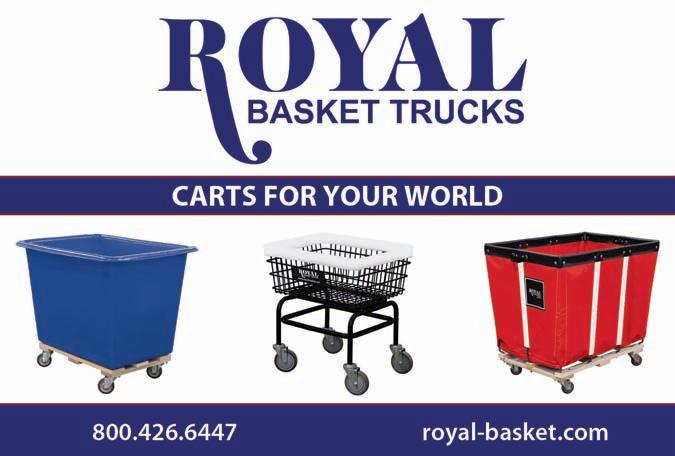
All businesses have the option to file on paper or electronically. For more infor mation or help completing the form, see the Census Bureau’s business help site at econhelp.census.gov or call 800-233-6136.
The first 2012 Economic Census re ports are slated for release in December. Federal Reserve Board Chairman Ben
Bernanke has called the census “indispensable to understanding America’s economy.” Taken every five years, the Economic Census “assures the accuracy of the statistics we rely on for sound economic policy and for successful business planning,” he says.
Interesting facts from the 2007 Eco nomic Census concerning dry cleaning and laundry services are available at business. census.gov. Examples there illustrate how Census Bureau economic statistics are used by local businesses for marketing and planning, as well as by government agencies and researchers. O
Nuts & Bolts of Routing - Practical Principles. One-day NCA course, to be held Jan. 6 in Nanuet, N.Y. Call 212-9673002 or e-mail ncaiclean@aol.com.
Basic Spotting 101. One-day NCA course, to be held Jan. 13 in Bronx, N.Y. Call 212-967-3002 or e-mail ncaiclean@ aol.com.

DEC Certification. Two-day NCA course, to be held Jan. 13 and Jan. 20 at a location to be announced, and Jan. 27 and Feb. 3 in Nanuet, N.Y. Call 212-9673002 or e-mail ncaiclean@aol.com.
Webinar: Understanding Good Cleaning and Drying for Alternative Solvents. To be held online Jan. 23. Call 212-967-3002 or e-mail ncaiclean@aol. com.
Avoiding Claims: What You Need to Know About Fabrics and Stain Removal. One-day NCA course, to be held Jan. 27 in Nanuet, N.Y. Call 212-9673002 or e-mail ncaiclean@aol.com.
DEC Certification. NCA course, to be held Jan. 27 and Feb. 3 in Nanuet, N.Y. Call 212-967-3002 or e-mail ncaiclean@ aol.com. O
Phone: 312-361-1683 E-mail: bbeggs@americantrademagazines.com
Feature: Buyer’s Guide
Our annual directory issue of manufacturers and suppliers is the most anticipated of the year—a valuable resource you’ll want to keep handy.
Editorial Submission Deadline — December 15
Feature: Restoration Services
Dry cleaners are cleaning up by helping save insurers money while they save customers’ possessions.
Showcase: Point-of-Sale Systems
Editorial Submission Deadline — January 15
Feature: Cutting Energy Costs
Dry cleaning plants require water, natural gas and electricity, and we share strategies for keeping your costs in check.
Showcase: Dry Cleaning Machinery: Perc
Editorial Submission Deadline — February 15
Feature: Clean 2013 Show Guide
We have complete listings of the exhibitors, educational sessions and events that make Clean the show you can’t afford to miss!
Editorial Submission Deadline — March 15

Feature: Boost Casualwear Sales
What you can do to gain more of the dress-down business.
Coin-Op Laundry A self-service laundry could make your plant a comprehensive fabricare center.
NOLA Know-How Here’s what to see and do while you’re in New Orleans for the Clean Show.
Editorial Submission Deadline — April 15
HANOVER, Mass. — Lapels Dry Cleaning recently opened two dry cleaning stores in Arizona’s East Val ley, in Gilbert and Ahwatukee, and was scheduled to open a third store in Chandler. The stores are locally owned and operated by Gilbert resi dents Jeff and Tanya Kline.
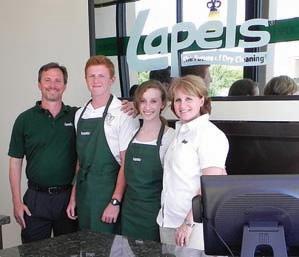
“We are delighted to bring Lapels’ standard of high-quality dry cleaning and superior customer service to our friends, neighbors and fellow East Valley residents,” says Jeff Kline.
Prior to opening the Lapels stores, he worked as an aerospace engineer. Tanya Kline continues her work as a homemaker and active community
volunteer (the couple has two chil dren), in addition to her role in their new business..
“There were so many reasons why we chose to purchase a Lapels fran chise,” says Tanya Kline. “The envi ronmental piece was certainly up there on our list, but it was an overall com mitment to a high-quality customer experience that truly sold us.”
Lapels uses the latest technology in equipment and cleaning solutions, and produces no hazardous waste in its dry cleaning process, the company says.
E ach Lapels stores offers a full slate of services, including same-day dry cleaning; shirt service; tailoring; shoe repair; wedding gown preservation; suede and leather processing; box storage; and fur storage.
“We want to congratulate Jeff and Tanya on joining the Lapels Dry Cleaning family, and we look forward to an ongoing relationship as we continue to provide guidance and support at the corporate level to help ensure the success of their new dry cleaning stores in the East Valley,” says Lapels Dry Cleaning CEO Kevin Dubois.
HOUSTON — Harris County (Texas) Attorney Vince Ryan reports that his office has reached a $2.175 million
settlement in a case against owners of a shuttered dry cleaning facility here for chemical contamination of groundwater.
The lawsuit accused Redonda Proper ties and Seven BC, doing business as San Felipe Joint Venture, SF Properties, and PMSV River Oaks, L.P. of allowing dry cleaning solvents to contaminate the soil and groundwater under and near the for mer Hallmark Dry Cleaners on San Felipe Road in the River Oaks area of Houston.
According to the lawsuit, the area is contaminated with perchloroethelyne (perc).
The judgment is for the largest sum ever in favor of a Texas county against owners and operators of a dry cleaner, Ryan says. Money from the settlement will be divided equally between Harris County and the State of Texas.
ELK GROVE VILLAGE, Ill. — Ruth Jones, owner of Foster-Stephens Inc., which produces storage solutions to pre serve and protect wed ding gowns and other family treasures, cele brated her 100th birth day this August.
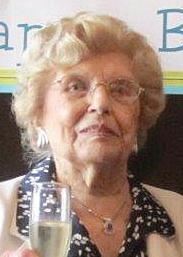
ter, Nancy, took over day-to-day duties at Foster-Stephens in the mid-’90s.
Ruth Jones remains chairman of the board and retains an active interest in the company. She also remains active in her community through bridge, church, and book clubs.
Asked to reflect on the industry chang es that she’s seen over the years, she says she has been most impressed with the au tomation advances and the changes that computers have brought about, both in business and at home.
She has watched Foster-Stephens transform from a company that mainly produced posters and other sorts of advertising for dry cleaners to one that now focuses on the preservation of wedding gowns and other textiles.
COLUMBIA, Md. — Howard County (Md.) police are on the lookout for two men who tied up two employees and robbed the ZIPS Dry Cleaners here.
Two employees were cleaning up after closing on the night of Nov. 9 when one of them went out the rear door to take trash to the Dumpster, according to police. As the employee returned, a masked gunman confronted him.
The employee was led to the office, where a second masked gunman was de taining the second employee.
Jones
She is the widow of founder Elmer “Bill” Jones, and was active in the company from the early 1970s until the mid-1990s. She began running the company when her hus band died in 1983. The couple’s daugh
The armed men tied up the employees using zip-ties, then took both employees’ wallets and two cash boxes from the of fice. One of the victim’s wallets was ▲
later recovered by a citizen a few miles away.
Suspect No. 1 is described as a black male, 5-10 to 6 feet, heavy build, wearing a black ski mask (dreadlocks showing) and a bright orange jacket. Suspect No. 2 is described as a black male, 5-4 to 5-6, thin build, wearing a black ski mask and black jacket.
The Columbia Patch interviewed one of the victims, evening manager Kevin Kim. He told the newspaper that ZIPS had added more security and instituted new policies to improve safety following the incident.
Police are investigating whether this robbery was connected to another inci dent during which a Taco Bell manager was critically wounded two days earlier at a restaurant less than two miles away. There were two masked suspects in that crime but the victims were unable to pro vide detailed descriptions.
FAIRFIELD, N.J., and LAUREL, Md.
— The Textile Care Allied Trades As sociation (TCATA) and the Drycleaning and Laundry Institute (DLI) have recently strengthened cooperation between the two organizations, TCATA reports in its most recent Tidings e-mail newsletter.
The boards of directors for both or ganizations have discussed ways that the two groups can work more closely to gether for the good of the industry.
Fred Schwarzmann of A.L. Wilson Chemical Co., a DLI board member,
American Drycleaner, January 2013
has been appointed official liaison to the TCATA board; Kevin Lawson of TriState Equipment has been appointed liai son to the DLI board.
The particulars will evolve over the years, TCATA says, but members of both organizations should expect to begin see ing more information about the other’s major activities.
“Increasing the level of communica tion and cooperation only makes sense,” says TCATA President Bryant Dunivan, from Energenics Corp. “The two associa tions have always had common interests, and the challenges that the industry has faced in recent years has only increased the need for and benefit of a closer rela tionship.”
TCATA and DLI joins three other ma jor associations in presenting the Clean Show, the textile care industry’s premier event, every other year.
GARDEN CITY, N.Y. — Donna R. Boyd, owner of Tip Top Cleaners, Cham bersburg, Pa., is being honored as a 2012/2013 NAPW Professional Woman of the Year by the National Association of Professional Women, a 400,000-member organization dedicated to helping women develop innovative business and social relationships.
Boyd’s Tip Top Cleaners specializes in expert, affordable dry cleaning and laundry services for the residents living in Pennsylvania’s Franklin County. She has built a reputation for consistently offering
convenience, quality, and personal service, NAPW says.
Tip Top Cleaners also offers special ized cleaning of leather and suede, plus preservation of bridal gowns. Besides her work at Tip Top, Boyd is active in the Greater Chambersburg Chamber of Com merce and local charity organizations.
LANCASTER, Pa. — Frank F. Filling Jr., 94, of Landis Homes, formerly of Lan caster, died Nov. 10 surrounded by family.
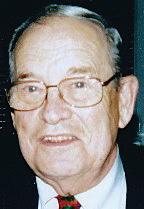
Filling was the retired president of Filling’s Inc. Dry cleaning, Men’s and Ladies Stores. He re tired in 1987 after 53 years with the Filling Corp.
Filling served as the president of the Central Pennsylvania Drycleaners Guild and the Pennsylvania Association of Professional Dry Cleaners. He was elected to the International Fabri care Institute’s Board of Directors and was instrumental in the formation of the Insti tute’s school in Maryland.
He was preceded in death by his wife, Mabel “Mae,” in 1999. He is survived by a son, daughter, two brothers, two sis ters, and three grandchildren. Memorial contributions may be made to Holy Spirit Lutheran Church, Lancaster, or the Millersville VFW Post 7294, 219 Walnut Hill Rd., Millersville, PA 17551.
GREENSBORO, N.C. — Watson Stoes sel “Sto” Fox Jr. , 71, Fox Cleaners, and executive director of the North Carolina Association of Launderers and Cleaners, died Nov. 2 after a fight with cancer.
Fox attended the University of North Carolina and served in the U.S. Air Force before beginning his professional career. He worked at Sedgefield Country Club and later the family business his father started in 1947, Fox Cleaners.
He also enjoyed a successful career as an employment recruiter while running Fox Cleaners. Fox’s children continue to operate the business today.
His passion for the dry cleaning in dustry led him to his post at the North Carolina Association of Launderers and Cleaners, where he achieved many notable accomplishments.
One of the most notable was the cre ation of the Dry Cleaners Trust Fund (DC SCA), which continues to help protect the environment and the existence of small businesses.
He was preceded in death by his wife, Gail Sandra Weber. Surviving him are four daughters, one son, and eight grandchil dren.
Memorial contributions in Fox’s name can be shared with Beacon Place and with Hospice and Palliative Care of Greensboro, 2500 Summit Ave., Greensboro, NC 27405. O
2013 RATES: One- to five-time rate: $2.40 per word, boldface $2.50 per word. Minimum charge: $25.00 per ad. Call or write for our three- and 12-time rates. If box number is used, add cost of 5 words. Display classified rates are available on request. All major credit cards are accepted.

PAYMENT FOR CLASSIFIED ADS: Must accompany order. DEADLINE: Ads must be received by the 1st of the preceding month. For example, for a June ad, the closing date is May 1st.
Most ads contain a phone number, street address or a U.S. Post Office Box number for reply. However, some advertisers choose an American Drycleaner confidential reply number. For these ads, address your reply to the box number printed in the ad, c/o American Drycleaner, 566 W. Lake St., Suite 420, Chicago, IL 60661, or fax replies to 312-361-1685. For more information, please con tact us at 312-361-1700.
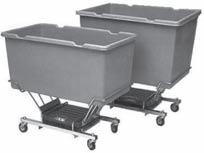
Own Your Own
Spotters, Tailors, Pressers! 100% Financing. Plant or Drop, location of your choice. Call 1-561-302-5031 or 1-888-275-6637.
• Hoffman Topper- 19” manual -Rebuilt
• Unipress TUF-Tension Form Finisher-Pre-owned
• Unipress 45 HOX-Hot Head Utility-Pre-owned
• Cissell Little Big Jim-Tensioning Pant Topper Pre-owned
• Forenta 4224-Double Hot Head LeggerPre-owned
• SILC Revolution-Tension Pant Topper “NEW”
• UniMac UW50PVQ-Pre-owned
• Continental H2055-Pre-owned
• Iowa Techniques 540 Slot Hi-Lo Conveyer
• Railex Assembly Wheel-New • Iowa Techniques Touch Up Unit
• Dyna Fluid Valves-1/2 or 3/4-New CENTURy LAUNDRy DISTRIbUTINg
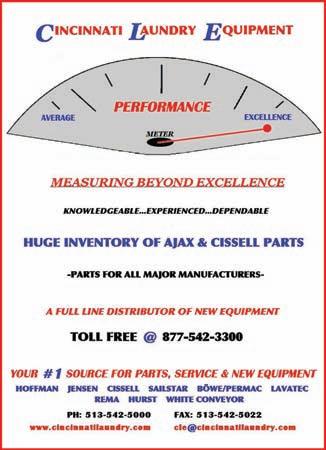
Website: www.centurylaundry.com Phone: 1-800-791-9321 E-mail: rmalcolm@centurylaundry.com
VAIL, COLORADO— Dry cleaner, spotter and mechanic will help. High volume and quality a must. Salary depends on experience. Must have four years experience. Fax resume to 970-479-2837
Plant Manager: Large drycleaning plant in Oklahoma City, OK. Prefer someone with man agement and drycleaning plant experience. Benefits and competitive salary. Email a resume to perryokc@coxinet.net or fax to 405-341-8794.
W ITHOUT-A-TRACE WEAVERS— More than 50 years’ experience. We are the experts in silks, knits, French weaving and piece weaving. Reasonable prices. Send garments for estimate to: 3344 W. Bryn Mawr, Chicago, IL 60659; 800-475-4922; www.withoutatrace.com.
SELL OR BUY A DRYCLEANER. WE HAVE BUYERS!!! PATRIOT BUSINESS ADVISORS
SPECIALIZES IN SELLING DRYCLEANERS IN NJ, PA, DE & MD. CALL LILIANE AT 267-391-7642.
www.americandrycleaner.com
American Drycleaner, January 2013 59


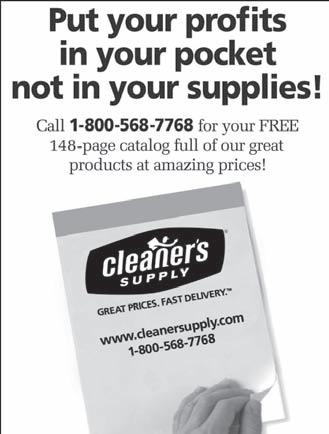

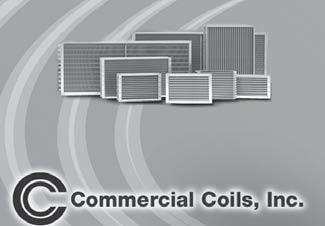
American Drycleaner and AmericanDrycleaner.com
E-News Web Print
American Drycleaner is the industry’s premier publication for news relating to dry cleaning plants. In it, you’ll find profiles of successful businesses and their owners, tips for running your operation more successfully, expert advice, and much more.
AmericanDrycleaner.com is your one-click site for all of the most up-to-date information on the industry today. Stories are updated daily to ensure you’re always informed. Plus, online tools such as the Distributors Directory and Buyer’s Guide will fulfill all of your plant’s needs.

Continued from page 64
of Gardner’s anniversary contest, in which one person won the grand prize drawing for a weekend for two at West Virginia’s The Greenbrier resort. … In an effort to ensure that area residents can weather the winter cold, Royaltone Chemical Co. and Tulsa, Okla., area dry cleaners have set up the Cleaners Coats for Kids (And Grown Ups Too!) campaign. The group will col lect, clean and repair donated coats at no charge, and give them to the Tulsa Neigh bor for Neighbor Organization for distribu tion to those in need. … Florida residents will no longer have to worry about an added expense when it comes to getting their clothes professionally dry cleaned and laundered, as the state legislature has repealed a sales tax on such services. The move to repeal the state tax was spear headed by members of the Neighborhood Cleaners Association.
50 YEARS AGO. Several coin-ops and clean ers may be feeling a bit short-changed lately, and it may be due to the rush ad journment of Congress a while back. As it was, a supplemental appropriation bill that contained $500,000 for the Bureau of the Mint was on the table, but wasn’t passed. This bill would have financed production of an extra 420 million coins. Many are feeling the coin shortage, especially in the Northeast and Midwest. In fact, a Chicago retail chain store spent $10,000 to bring in coins from other cities, and some banks are even rationing change to customers. Trea
To read more about American Drycleaner’s first 75 years in the industry, visit AmericanDrycleaner.com.
sury and Federal Reserve officials are hop ing to get quick approval from the Budget Bureau and key members of Congress to spend funds not earmarked for production costs. … Residents of the Minneapolis-St. Paul area are getting added help in their efforts to provide warm blankets and com forters to aid thousands of refugees left homeless by the recent earthquake in Iran. Irving Victor, executive vice president of the Vic Mfg. Co., is providing the test fa cilities of the Vic plant for the cleaning of donated blankets and comforters. Within 10 days, more than 8,000 donated blankets and comforters were cleaned and placed aboard a plane for direct shipment to Iran.
75 YEARS AGO. Dry cleaner Ray Vermeers has mastered the mechanics of removing the ring when it comes to spot cleaning. Vermeers perfected his craft while spend ing three years instructing in spotting, dyeing and dry cleaning at the National Association Institute, as well as teach ing his method to the staff of spotters at the Union Dye Works in Kenosha, Wis., where he serves as superintendent. His solution involves one-half water and onehalf peroxide. He then adds a couple drops of sulfonated alcohol, which will help the solution penetrate fabrics. Vermeers mixes this concoction right in the bottle that cleaners will use to spray the solution. Once sprayed, all there is to do is hang the garment until it is dry enough to be pressed or ironed. … And the award goes to... Lungstras Dyeing and Cleaning Co.! The St. Louis, Mo.-based company has won the title of “Ad of the Year” from American Drycleaner, after successfully winning the “Ad of the Month” title this past June. O — Compiled by Carlo Calma
10 YEARS AGO. Michael Nesbit, partner and chief of operations for Conroe, Tex.-based Nesbit’s Cleaners, has the formula for what it takes to nab the “Best Plant Design” accolade: an alldrive-thru plant. Nesbit’s newest endeavor has awarded his company with the recognition in American Drycleaner’s 42nd Plant Design Awards. Operating much like a bank, the plant has three drive-thru lanes equipped with an audio system for communication between service reps and clients, while vacuum tubes are installed to handle payments. What sets Nesbit’s drivethru apart is that it utilizes customer identification through video cameras that focus on a customer’s license plates, alerting employees to whom they are serving. “Any person can look up and see the license plate, enter it in the computer and say, ‘That’s Joe Smith,’” says Nesbit. For customers who can’t make Nesbit’s usual operating hours, the facility also provides an Iowa Techniques depository for drop-offs,

and Sycamore Systems lockers for pick-ups. The service costs the company just 2% more than having only a counter, according to Nesbit, which he hopes provides added convenience to his clientele. “From the consumer’s perspective, it’s a lot more convenient,” says Nesbit. “They don’t want to stop what they’re doing for a ‘necessary nuisance,’ which dry cleaning is.”
25 YEARS AGO. Ruth and Omer Elam, co-owners of Gardner’s Gentle-Care Drycleaning and Laundry in Charleston, W.Va., capped off the celebration of their 70th year in the business by constructing the Frances B. Gardner Park. Developed with cooperation from the city and private funds from Gardner’s, the park features four benches and three picnic tables, and provides a spot for residents to picnic along the bank of the Elk River. Ruth dedicated and named the park in honor of her mother, Frances, who not only founded the business with her husband, Abe, in 1917, but is also regarded as Charleston’s first prominent businesswoman. At the dedication ceremony, the Elams were joined by friends, employees and several dignitaries from the city, including Mayor Mike Roark, for a catered picnic. Also attending were weekly winners

